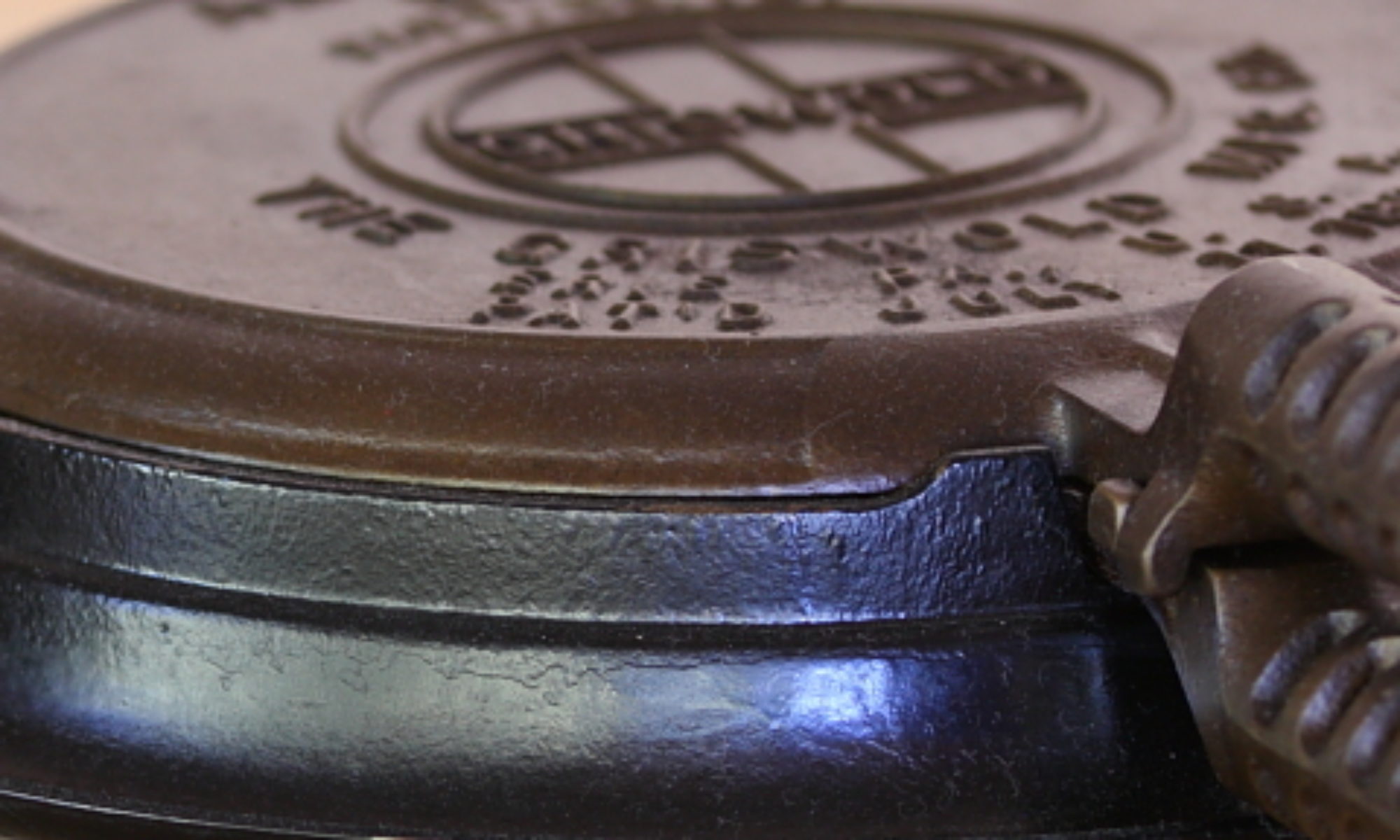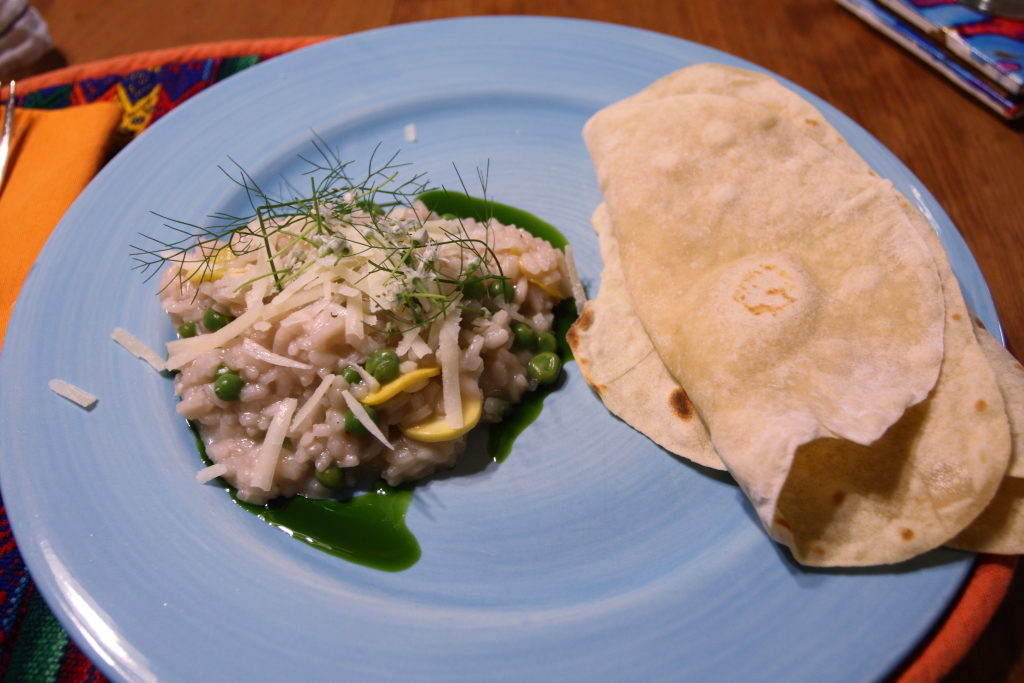
We had a dish similar to this eating out while in St. Louis (specifically at Small Batch, a great little restaurant on Locust Street), and we knew that we could make something like it. Of course, if you know that primavera refers to spring vegetables, and know how to make risotto, you can guess how to make this dish. If not, you might want to try scratchin’ this out for dinner some evening.
We’ve been making risotto of one sort or another for years, so long that we really don’t use any recipe; we just modify the ingredients based on what we want in the dish, and what we have on hand.
For those who don’t know, risotto is probably our favorite Italian dish, and with good reason. When done correctly, it’s a creamy, cheesy, rice dish bursting with flavor. A true Italian comfort food. But, it does have a somewhat-deserved reputation for being troublesome: a lot of stirring, and it can be finicky to get exactly right. Even after years of making it, sometimes our risotto doesn’t come out quite right. But, we keep trying, because sometimes it’s perfect.
Primavera Risotto with Fennel Oil
Ingredients
- 2-3 cups vegetable stock simmering
- 2 Tbs unsalted butter
- 1/4 cup finely minced onion
- 1 garlic clove finely minced
- 1 cup arborio rice
- 1/4 cup dry white wine such as Pinot Grigio
- 1 cup assorted spring vegetables cut into small pieces
- 3-4 Tbs grated Pecorino Romano cheese
- Kosher salt
- Freshly ground black pepper
- Fennel oil optional, for serving
Instructions
- Place stock in a small saucepan and bring to a simmer. Reduce heat to keep hot.
- Melt butter in a large saucepan over medium heat. Add onion and garlic, sprinkle with salt, and cook until translucent and tender, but not browned, about 5 minutes.
- Add arborio rice, stir to coat, and add wine. Cook, stirring continuously, until wine is absorbed.
- Add stock, 1/3 to 1/2 cup at a time, stirring and cooking until completely absorbed before adding more. Continue adding stock until the rice is nearly done -- it'll still be crunchy in the very center -- then add the vegetables along with the stock.
- Once the rice is done - it should still be chewy in the center - stir in cheese, cover, and remove from heat. Let stand 5 minutes before seasoning to taste with salt and pepper.
- Serve with a drizzle of fennel oil and additional grated cheese on top.
Ingredient discussion:
We don’t specify the vegetables, but it should include some of the bright greens of spring, such as asparagus, peas, snow peas, and, perhaps, a bit of scallion. Add some small pieces of bright yellow summer squash — the first- picked, tiny ones are perfect, and any other vegetables that strike your fancy. To make risotto, you must use arborio rice (actually, a few other rices work, but arborio is the most common). It’s a short grained rice that releases starch while cooking, making the creamy broth of a great risotto. You can use many cheeses in place of the Pecorino: Parmesan, or chèvre, for example; we’ve even used Cheddar. Just use good-quality cheese. Finally, the fennel oil is optional — it’s mainly there for color — but we’ll show you how to make it in tomorrow’s post.
Procedure in detail:
Heat stock. One of the secrets to making risotto is only to add hot stock. This keeps the rice cooking and releasing starches as you work, instead of having it cool down after each addition, which would stop releasing the starch. So, place the stock in a saucepan and bring it to a simmer. Once simmering, reduce the heat even further to keep it hot and steaming.
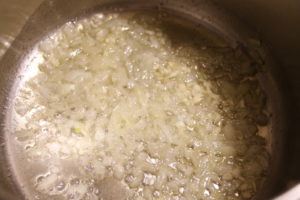
Cook onions and garlic. Melt the butter in a large saucepan over medium heat. Once melted and foamy, add the onion and garlic — we like to sprinkle them with a bit of salt right at the beginning — and cook, stirring very often, until translucent and tender, about 5 minutes. Try not to let them brown; instead, try to get that delicious soft onion-garlic mixture.
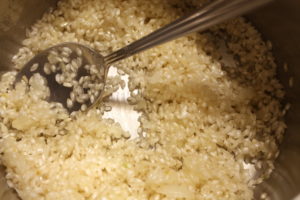
Add rice and coat. Add the arborio rice and stir to coat. Some people suggest toasting the rice at this stage, basically cooking it in the butter until it smells toasty. We don’t suggest that, as we find that cooking the rice more than a minute, or two at the most, will “seal” the rice, making it harder to release the starch during later cooking stages. Just stir the rice until it’s coated and glossy.
Add wine. Pour in the wine and start stirring. This is practice for what’s coming. Keep stirring until all the wine is evaporated and absorbed, but the rice hasn’t started to stick to the pan, about 5 minutes.
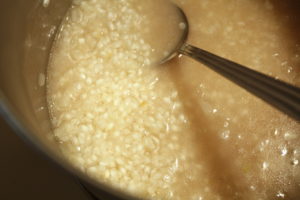
Add stock and stir. Add about 1/3 to 1/2 cup of the hot stock — a ladle comes in handy here to scoop the stock into the rice. Now stir. Just a nice, even stirring, nothing ferocious. Keep stirring, and just as with the wine, continue until all the stock is absorbed or evaporated.
Repeat. Keep adding stock and stirring in just the same way. You’ll notice that each time the broth is creamier than the last. After about 3 additions, perhaps 15 minutes, test the rice for doneness. Bite into a grain to check its crunchiness. You want the center just slightly crunchy. Not chewy, but slightly crunchy, as if there’s a nugget of raw rice in the very center. This is the cue that your rice will be done perfectly in about 5-7 minutes.
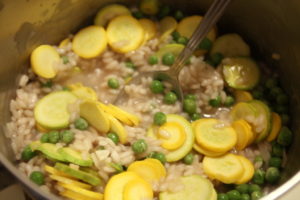
Add vegetables. Stir in the vegetables and more stock. Continue stirring and testing the rice as you work. You want the vegetables to cook along with the rice, and you want the center of the rice slightly chewy. When your rice is ready, remove it from the heat.
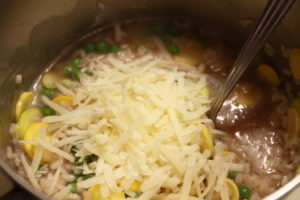
Stir in cheese. Add the Pecorino Romano and stir it in. Cover the risotto and let it stand for about 5 minutes so the cheese can melt. Then give everything a bit of a stir, and, if your risotto isn’t creamy enough, add a couple of tablespoons of stock (or cream, or a tablespoon of butter) and stir in.
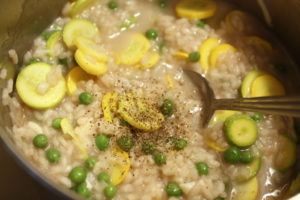
Season. Taste, and add salt and pepper, as needed. If you think it needs a bit more cheese, add it now, too.
Serve. We served ours by drizzling a bit of fennel oil onto the plates for color, scooping the risotto over it, and sprinkling a bit of additional Pecorino Romano on top.
We love risotto, and we love the way it can be varied according to the seasons. In springtime, you can use light, fresh spring vegetables, in winter, you can use heavier ingredients such as porcini mushrooms, and, no matter what, it tastes great. The only downside is that it does take effort, time, and practice to turn out great risotto (even most restaurants, places that should be able to make it correctly, get it wrong 90% of the time), but it’s a skill well worth cultivating. Four stars.
